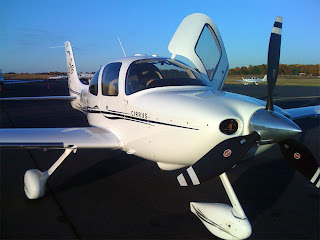G1000 transistion training - emergencies - final flight

For the final flight in my G1000 transition course we focused on failure scenarios. Not the "engine goes POOF" kind but the avionics kind. Normal situation This picture shows what the 2 Garmin screens show in a normal (non failure) situation. You can see we have 2 screens - the left PFD focusing on flight performance (airspeed, heading, attitude, altitude) and the right screen (MFD) focusing on engine data, mapping, checklists, and everything else. Failed PFD screen In this scenario the screen that is right in front of you (the PFD) has failed. This basically means the screen has gone dark. We simulate that by dimming the screen down to 0% brightness. After darkening the PFD we shot a GPS approach into Rock Hill. When this failure has occured you shift the G1000 into Reversionary mode. That means the info that is normally split across 2 screens is now merged into 1. It actually duplicates the same data on both screens, but since the PFD screen is no longer functioning...
